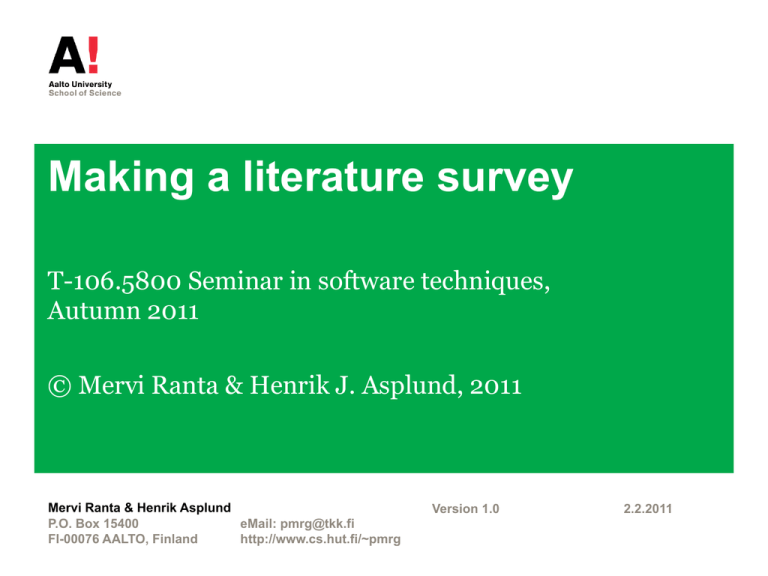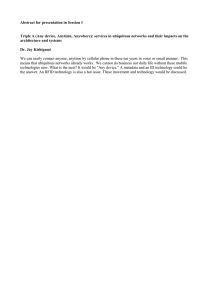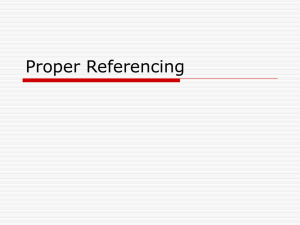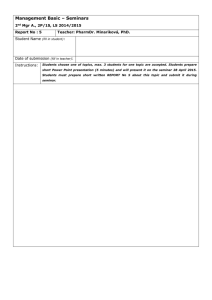Making a literature survey
advertisement

Making a literature survey T-106.5800 Seminar in software techniques, Autumn 2011 © Mervi Ranta & Henrik J. Asplund, 2011 Mervi Ranta & Henrik Asplund P.O. Box 15400 eMail: pmrg@tkk.fi FI-00076 AALTO, Finland http://www.cs.hut.fi/~pmrg Version 1.0 2.2.2011 Making a literature survey • • • • • • • • • Objectives Reliability, sources and referencing Answers to some questions on surveys Processing literature survey Template for the survey Example of the content of a literature survey Applying the table of contents and some tips Guiding sessions Contact information 2 Objectives of literature survey • Gaining an understanding on the fundamentals and state-of-the art of the area • Learning the definitions of the concepts • Access to latest approaches, methods and theories • Discovering research topics based on the existing research 3 Objectives of literature survey • Concentrate on your own field of expertise – Even if another field uses the same words, they usually mean completely different thing • It improves the quality of the literature survey to exclude sidetracks – Remember to explicate what is excluded • “Jack of all trades is master of none.” 4 Reliability and validity in research • The challenge of research is to ensure that the used sources of information, experimentation settings and methodologies are reliable. – Knowing what are the assumptions, restrictions and open questions makes possible to evaluate the reliability and applicability of the knowledge. – Prerequisite for reliability and sharing information is that the researcher uses only the concepts, theories and methods of own discipline. – Concepts of two different theories are not interchangeable 5 Valid sources • • • • Refereed article in a journal or a conference Book published in scientific series Articles referred to in other articles are excellent sources At some stage you will learn to evaluate the coherence and concept definitions • TKK library has courses and material on searching for scientific information – http://lib.tkk.fi/Opetus/Informatiikka/ 6 Wikipedia is not a source for scientific writing • Wikipedia has no formal and strict refereeing – Reviewers in wikipedia can be from a completely different field • The disciplines get mixed up in wikipedia – Wikipedia articles try to cover every discipline, which causes loss of the focus • Wikipedia is modified constantly which hinders checking the reference – Reader of the literature survey must be able to access the exactly same text as the author • Even Encyclopaedia Britannica is not a source for scientific information – Encyclopaedias list facts, but not the reasoning or research methods behind them 7 Answers to some questions on surveys 8 Concepts containing several words • Do not separate words constituting a concept – For example “ubiquitous computing” is not “ubiquitous” + “computing” – Merriam-Webster • Ubiquitous = • : existing or being everywhere at the same time : constantly encountered : widespread <a ubiquitous fashion> – Computing = • : to determine especially by mathematical means ; also : to determine or calculate by means of a computer – This does not define ubiquitous computing at all • Taking the meanings of separate words from a dictionary does not work • Always find the definitions for concepts from scientific publications 9 Generally known concepts? • If you have to consider whether a concept is generally known or not, put the definition in your survey – Examples of what you do not have to define • Computer, mouse, program – Examples of what you have to define • Machine learning, ubiquitous computing, context awareness • However, you may assume level of knowledge of a fourth year student of computer science – In a very focused conference or journal for professionals of a certain field, one can assume that the readers have a strong background • Always define the central concepts – If an everyday word is used in a specific precise way, give a definition 10 Original source • Always search the original article that presented the result – Chaining the references changes the information due to the different interpretations of the authors • The original the source is, the more stabile and reliable it is (e.g. Weiser) – Even if technology developed rapidly the basic ideas, methods and theories usually maintain their value – Very fresh articles may be confusing, since they occasionally reflect the current buzzwords and hype 11 Keeping own ideas separate • The literature survey must replicate the essential content of the source and avoid too much interpretation • The author of the literature survey can select the viewpoint and choose what is essential according to that • Own conclusions, opinions and interpretations must be separated clearly from the content in sources 12 Referencing • Skillful referencing makes your literature survey much more valuable • The more citations your survey has, the more reliable it becomes – Note: quantity does not compensate the lack of quality in citations • The seminar recommends using Harvard style – Check e.g. • http://lib.tkk.fi/en/instructions/guides/citations/bibliography.html 13 Processing literature survey 14 Processing literature survey 1/5 • Select sources – Reading the articles you were given allows you to define your precisely focused topic – Choose some of the given articles and search additional ones from article databases • Even if you stick to the given articles, visit the article databases to get a grasp of literature search – Focus your topic carefully • Also limit the number of articles to be feasible as a seminar assignment 15 Processing literature survey 2/5 • Read papers – While searching for articles, boldly drop those that do not exactly match your topic • Check first keywords, abstract and conclusions – Read the chosen relevant articles so carefully that you understand the content really well • Scientific papers are much more difficult and require more time than a typical textbook. – Reading the references of the paper usually helps with understanding the text – Particularly the concept definitions are important 16 Processing literature survey 3/5 • Write survey – Explain in your text the content to a reader who has never read the paper • It is necessary to define concepts, give reasons and explain things with many sentences. – Explain the relevant points in a coherent manner • To make a better survey, you should focus your survey to only some topics mentioned in the papers. – Use proper citations so that readers always knows the source of the information – Separate clearly your own comments and conclusions 17 Processing literature survey 4/5 • Start the work immediately – Making a literature survey is laborious and demanding task – Running out of time is inevitable, if you do not follow the timetable • Proceed gradually – Process the sources in gradual manner to ensure getting a finished version within the time limits – E.g. first read 2 most relevant articles and write a survey on them • Then enhance by processing one article at a time 18 Processing literature survey 5/5 • Produce intermediate versions to allow review and guidance – List and description of sources • Prepare at least this for the first guidance session – Draft versions – according to your writing style • Table of contents, planned content as bulletins, concept definitions... • Key words, key sentence, key chapters... 19 Template for the survey • Please use the following word template – http://tinyurl.com/Survey-template • Contact the seminar staff, if you have a very strong reason to use another template or software 20 Example of the content of a literature survey • Title and author – Name, student id and other information as usual • Abstract (summary) – Brief presentation of the content • Keywords – Give a list of names of essential concepts, approaches and methods that you have covered in your work – Do not just collect some words that just sound nice 21 Example of the content of a literature survey • Introduction – – – – What is the topic and why it is important To what larger wholeness the survey topic belongs What you plan to accomplish in your literature survey Remember to briefly explain the content • Definitions of concepts – – – – Description of the meaning of the concept Possible competing definitions Concepts that might cause misunderstandings and confusion Possible methods and approaches • The actual content with appropriate titles – E.g. description and comparison of approaches, methods and models and examples. 22 Example of the content of a literature survey • Conclusions – Most important discoveries and conclusions – Proposals for further research – Separate your own argumentation clearly from the work of others • References – A good list of references is important – Has to follow some known referencing practice (E.g. Harvard referencing) 23 Example of the content of a literature survey Title and author Abstract Keywords Introduction Lists Formulas Concepts definitions Figures Tables Content Charts, diagrams Conclusions References 24 Appendices Applying the table of contents • It is not necessary to directly follow the previous example of table of contents. • Please do apply it according to your topic! • If you decide to deviate from these guidelines, consider what you are doing thoroughly - these guidelines are found to be a best practice. 25 Some tips: abstract • The idea is to write an informative abstract. • The abstract must show the reader very quickly whether the full report is valuable for further study. • It must function as an individual text, and not be worthless even if it is not accompanied by the report itself. • The abstract must be short, concise (give a lot of information in few words, brief but comprehensive), but completely selfexplanatory. (Abstracted from Davis, M: Scientific papers and presentations, 1997, p. 101). • The abstract should be from a half of a page to one page long. 26 Some tips: conclusions • It is crucial that you spend much effort on the conclusions, as that contributes to the work of the next stage. • Conclusions is the best place to present your own ideas in a literature survey. – Otherwise, a literature survey is meant to cover the work done by others in the research field. • As always, avoid mixing your opinions with the opinions of the authors of the sources. 27 Some tips: figures • Always remember to include also corresponding explanatory text in your literature survey when including a figure, image, picture etc. • The caption is simply not enough, it does not tell the reader unambiguously why the element is there, what you are planning to say with it and what does it tell. • If you include a figure (or table, diagram etc.) from a source, remember to put the reference also to the caption 28 Guidance sessions • Several guidance sessions – Check the timetable • Each student has to participate to at least one session – Individual guidance – Common topics and questions • Prepare for the session – – – – Questions Table of contents Draft of literature survey Draft of presentation • If you sent the materials at least one day in advance, you will get better and more focused guidance 29 List and description of sources • • • • • • • • Name and number of the student: Tentative title of the survey: Sources: Sources have been: found/browsed through/studied How will you focus your survey: Language of the survey: Language of the presentation: Questions: 30 Are draft versions of the literature survey graded? • No, they are not graded. • Drafts serve merely guidance purposes • Therefore, it is of your interest to submit drafts as early as possible • If you have specific questions, please mail them with your draft, so that staff notices to check things that you are not sure about 31 Contact information • Please do not hesitate to contact us, if you have any questions or you just want to check something – pmrg-assari@cs.hut.fi – Please notice: • Keyword “MVD:” in the subject field of your e-mail helps to avoid confusion with spam mail – email subject could for example be “MVD: The seminar assignment” • Even when teachers send e-mail from their own accounts, please remember to answer to pmrg-assari@cs.hut.fi, which is read and answered by several people • You are welcome to join events that PM&RG arranges for its hangarounds, special interest group, students, tutor group etc. Invitations are published at – Home page http://www.cs.hut.fi/~pmrg/ 32



